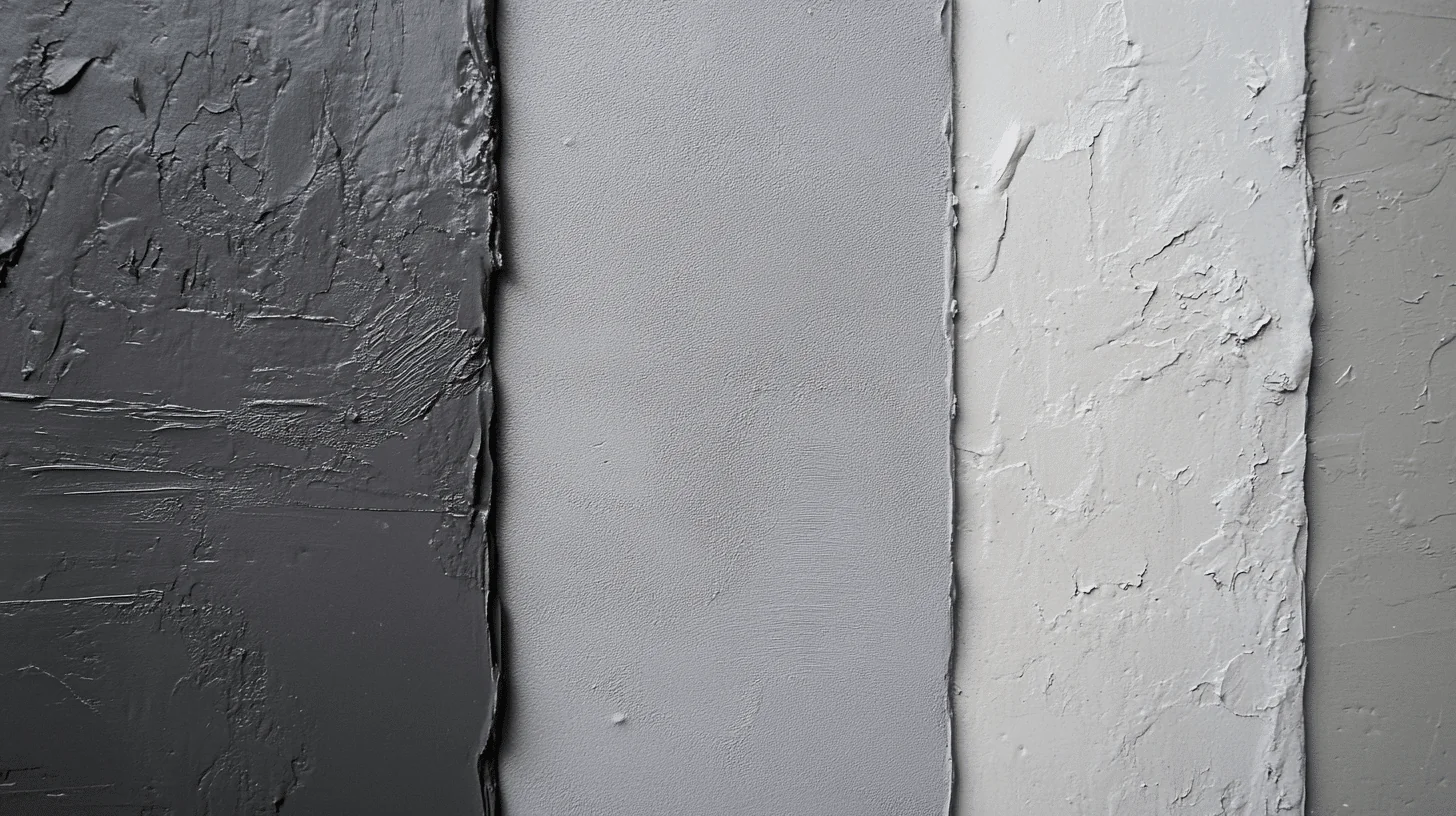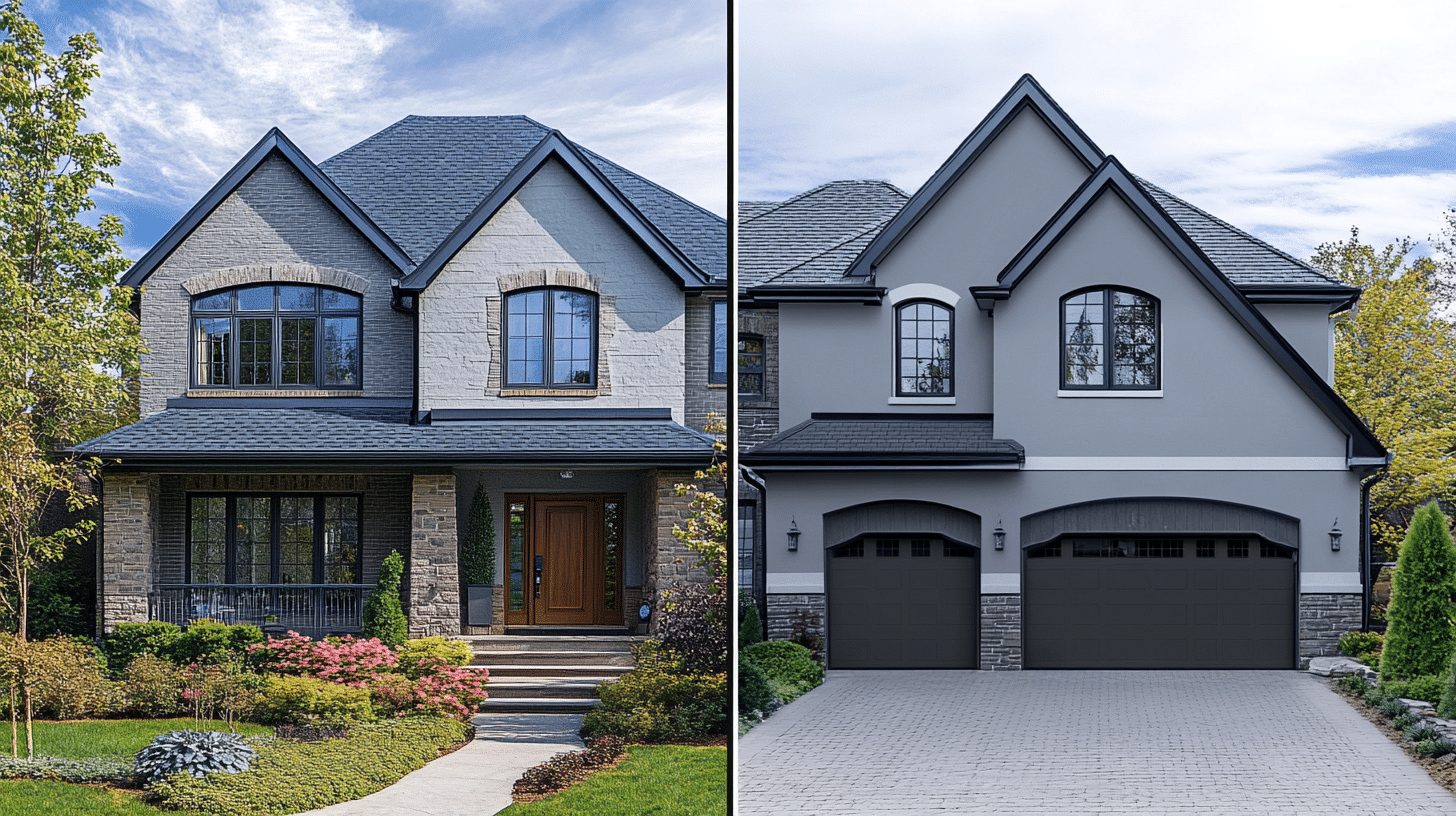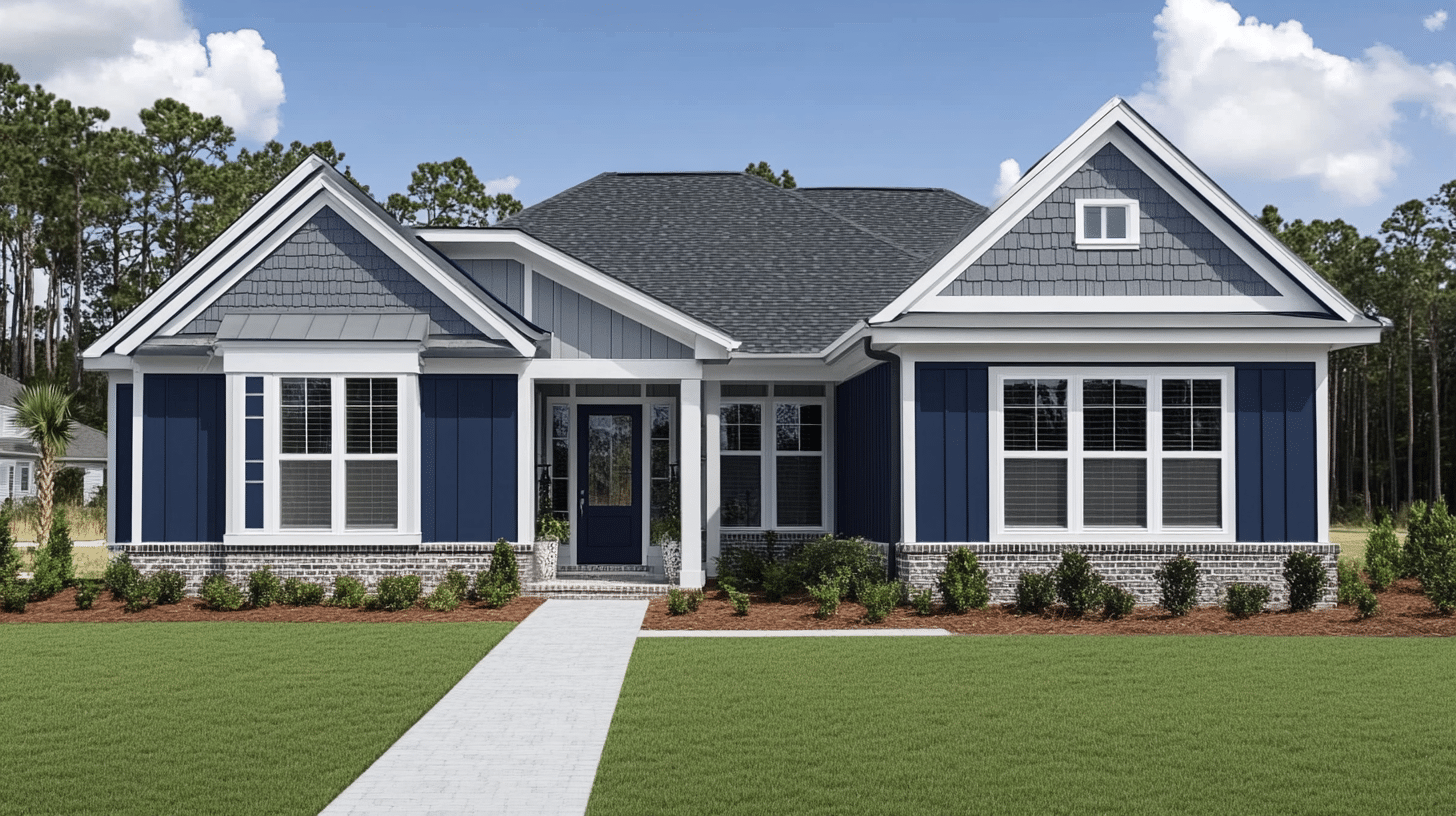Benjamin Moore’s Coventry Gray (HC-169) has been among the most trusted exterior paint colors in recent years.
This medium-toned gray brings a refined presence to home exteriors while maintaining remarkable versatility across different architectural styles.
Gray exteriors continue to define modern home design, offering a perfect middle ground between stark white and bold dark shades.
As homeowners move away from beige and tan options, grays like Coventry provide an updated look that stands the test of time.
What sets Coventry Gray apart is its ability to enhance architectural details without overwhelming them. Its balanced tone works beautifully across various materials, from traditional wood siding to modern fiber cement.
For homeowners seeking a color that combines contemporary appeal with lasting style, Coventry Gray deserves careful consideration.
Understanding Coventry Gray
Color Profile

Coventry Gray is a trusted medium-toned neutral in Benjamin Moore’s Historical Colors collection. Its true gray base carries subtle undertones that add depth without overwhelming the home’s exterior appearance.
The color has an LRV (Light Reflectance Value) of 48.18, which places it perfectly in the middle range of the scale.
This balanced position allows it to maintain its character in various lighting conditions while providing enough depth to highlight architectural features.
The paint’s undertones lean slightly cool but avoid the stark, clinical feel of many contemporary grays.
This natural balance suits it, particularly for exterior applications where color stability is crucial.
Lighting Effects

Natural light transforms Coventry Gray throughout the day, revealing its subtle character changes. Morning light brings out its softer aspects, while the midday sun showcases its neutral nature.
North-facing walls display the color’s cooler side, creating a sophisticated, timeless appearance that many homeowners seek.
South-facing surfaces benefit from strong natural light, whereas Coventry Gray maintains its integrity without washing out.
Afternoon sun can warm the color slightly, adding richness to the overall appearance.
These subtle shifts help create visual interest across different faces of the home while maintaining a cohesive look.
Comparison with Other Grays
Coventry Gray vs. Stonington Gray

Stonington Gray, with its higher LRV of 59.36, appears notably lighter than Coventry Gray on exterior surfaces. While both colors share a cool base, Stonington Gray often shows more apparent blue undertones in outdoor settings.
Coventry Gray proves more effective on larger exterior surfaces where color consistency is essential. Its deeper tone provides better coverage and creates dramatic shadows around architectural details.
Coventry Gray vs. Other Popular Grays

Unlike Coventry Gray, Revere Pewter shifts toward the warmer greige spectrum, making it less reliable for traditional gray exterior schemes. Gray Owl, while popular, sits lighter on the scale and can appear more variable in changing outdoor light.
Metropolitan offers perhaps the closest match but lacks the refined depth that makes Coventry Gray particularly suited for exterior applications. These comparisons highlight Coventry Gray’s unique position as a reliable exterior paint choice.
Ideas Featuring The Coventry Gray Paint
Homes Featuring Coventry Gray

Traditional colonials painted in Coventry Gray showcase the color’s ability to highlight detailed trim work and architectural elements. The paint’s medium tone creates natural shadows that bring depth to exterior features without appearing heavy or dark.
Modern farmhouse designs benefit from Coventry Gray’s clean, contemporary feel. On board and batten siding, the color shifts subtly between the raised and recessed areas, creating visual interest across large surfaces.
Ranch-style homes use Coventry Gray to achieve an updated look while maintaining their classic appeal. The color creates a timeless exterior palette that enhances curb appeal when paired with white trim and dark shutters.
Before and After Transformations

An outdated beige colonial transformed with Coventry Gray demonstrates the color’s modernizing effect. The change brought renewed attention to the home’s architectural features while maintaining its traditional character.
A 1960s ranch house updated with Coventry Gray shows how the color can bridge different architectural eras. The renovation preserved the home’s mid-century lines while bringing its exterior firmly into the present.
This versatile gray proves particularly effective when updating older homes with mixed materials. The color unifies brick and siding sections while respecting the original architectural intent.
Interactive Visualization Tools

Benjamin Moore’s website offers a digital visualization tool where homeowners can preview Coventry Gray on sample house styles. Users can envision their projects by adjusting variables like trim colors and architectural styles.
Professional paint retailers often provide specialized apps for more accurate color previews.
To create realistic visualizations, these tools can account for existing exterior elements like roof color and landscaping.
Local Benjamin Moore dealers frequently offer color consultation services, including digital rendering. These personalized services help homeowners understand how Coventry Gray will appear on their home’s exterior.
Complementary Colors and Design Suggestions
Selecting the right color combinations ensures your home’s exterior creates lasting curb appeal. Coventry Gray is an excellent base for various color schemes, from classic to contemporary.
Color Combinations for Coventry Gray Exteriors

| Element | Color Options | Notes |
|---|---|---|
| Trim | Chantilly Lace OC-65 | Bright, crisp white for clean contrast |
| Simply White OC-117 | Softer white with subtle warmth | |
| Decorator’s White OC-149 | Classic white with neutral undertones | |
| Shutters/Doors | Hale Navy HC-154 | Rich navy for traditional appeal |
| Black HC-190 | Timeless contrast for focal points | |
| Iron Mountain 2134-30 | Deeper gray for subtle variation | |
| Accent Details | Chelsea Gray HC-168 | Darker gray for architectural elements |
| Bronze Tone 2166-30 | Warm accent for detail work |
Materials and Natural Elements

| Material Type | Best Pairings | Effect |
|---|---|---|
| Roofing | Charcoal Gray Shingles | Creates seamless transition |
| Black Architectural Shingles | Adds sophistication | |
| Weathered Wood Tones | Provides natural contrast | |
| Stonework | Gray Stack Stone | Blends naturally |
| Beige Limestone | Creates warm contrast | |
| River Rock | Adds textural interest |
The key to success with Coventry Gray lies in maintaining balance across all exterior elements. A well-planned color scheme considers your home’s architectural style and existing materials.
Natural stone and brick elements pair beautifully with Coventry Gray’s neutral base. The paint color helps unify different exterior materials while allowing each component to contribute to the overall design.
Expert Insights and Reviews
Pros of Using Coventry Gray on Exteriors
Coventry Gray excels in maintaining its color stability across different weather conditions. Professional painters note its reliable coverage and consistent appearance, even when applied to large exterior surfaces.
The color’s middle-range depth makes it practical for homes in various settings. Urban homes benefit from their sophisticated presence, while suburban properties appreciate their ability to stand out without overwhelming neighboring houses.
Designers praise its compatibility with different architectural styles. The versatile shade adapts well to traditional detailing and modern clean lines, making it a safe choice for exterior updates.
Cons and Considerations
Sun exposure can affect how Coventry Gray appears throughout the day. Home sections facing different directions might show slight variations in tone, though these changes remain within an acceptable range.
Some homeowners might find the color too subtle. While this neutrality serves many homes well, those seeking more dramatic curb appeal might prefer darker or more saturated options.
Regional climate conditions can influence the paint’s appearance. Due to the varying quality of natural light, coastal areas might notice slightly different undertones compared to inland locations.
Maintenance and Durability
Benjamin Moore’s advanced exterior formulations help Coventry Gray maintain its appearance. The paint resists fading and chalking, which are common issues with exterior applications.
Low-lustre and satin finishes prove most successful for exterior applications of Coventry Gray. These sheens provide optimal durability while minimizing the visibility of surface imperfections.
Regular maintenance keeps Coventry Gray looking fresh for years. Simple annual cleaning prevents dirt accumulation and helps the paint’s true color remain visible.
Application Tips and Best Practices
Preparing Your Exterior for Painting

Professional-grade surface preparation significantly improves Coventry Gray’s final appearance. Start by thoroughly pressure washing all exterior surfaces to remove dirt, mildew, and loose paint.
Proper repairs to damaged siding or trim must precede any paint application. Wood surfaces need special attention, with all rotted sections replaced and loose boards secured firmly.
Premium exterior primers create an ideal base for Coventry Gray. The right primer helps the paint adhere better and ensures true color development across different surface materials.
Choosing the Right Paint Finish

The satin finish offers an ideal balance for most Coventry Gray exterior applications. This finish level provides enough sheen to shed water while maintaining the color’s sophisticated appearance.
Low-luster options work well on homes with older siding or minor surface imperfections. The slightly lower sheen helps hide flaws while offering good protection against weather exposure.
Pearl finish provides another excellent option for trim work painted in Coventry Gray. This finish level subtly contrasts the main siding areas while maintaining good durability.
DIY vs. Hiring Professionals

Large exterior painting projects require significant preparation and proper equipment. For proper application, most two-story homes need professional-grade ladders, scaffolding, and spraying equipment.
Professional painters bring valuable experience with Coventry Gray’s application nuances. They understand how to achieve consistent coverage across different surface materials and challenging architectural details.
Cost considerations should include more than paint and labor prices. Equipment rental, proper safety gear, and time investment often make professional application a practical choice for most homeowners.
Purchasing Information

Where to Buy Coventry Gray Paint
Benjamin Moore distributes Coventry Gray through authorized local retailers nationwide. These dealers offer personal service and expert advice about exterior paint applications.
Many Benjamin Moore stores provide color-matching services and custom mixing. Professional staff can help ensure your Coventry Gray matches exactly across different paint batches.
Local paint stores often maintain relationships with professional painters in your area. They can recommend experienced contractors familiar with Coventry Gray’s exterior applications.
Pricing and Product Options
Benjamin Moore’s Aura Exterior Paint line offers premium performance for Coventry Gray applications. This top-tier option provides superior coverage and excellent color retention.
Regal Select Exterior provides a strong mid-range choice for most home projects. The paint balances quality and value while maintaining good durability.
Ben Exterior Paint offers a budget-friendly option for Coventry Gray applications. This line still provides reliable coverage while keeping costs manageable for larger projects.
Estimating Quantity Needed
A typical two-story, 2,500-square-foot home usually requires 10-15 gallons for body color. Additional paint needs depend on trim coverage and number of coats required.
Surface texture affects paint coverage significantly when using Coventry Gray. Rough surfaces like stucco or textured siding may require up to 20% more paint than smooth surfaces.
Most exterior projects benefit from purchasing an extra gallon for future touch-ups. This ensures exact color matching for any needed repairs or maintenance.
Final Thoughts
Coventry Gray is a reliable choice for homeowners looking to update their exterior with a timeless color.
Its balanced tone and proven performance make it worth considering for your next painting project.
Before deciding, sample Coventry Gray on your home’s exterior.
Paint small sections on different sides of your house and observe how the color changes throughout the day. This simple step helps ensure you’ll be happy with the results for years.
If you’re planning an exterior painting project, Local Benjamin Moore dealers can provide personalized guidance and color consultation services.
Their expertise will help you achieve the sophisticated, polished look you envision for your home with Coventry Gray.
Frequently Asked Questions (FAQs)
Is Coventry Gray a Good Exterior Color?
Coventry Gray is an excellent exterior color, suiting various home styles, climates, and architectural designs. Its neutral undertones make it versatile for both modern and traditional homes.
What Colors Go Well With Coventry Gray?
Coventry Gray pairs beautifully with crisp white or off-white trims, black or navy accents, and natural wood tones. Bright reds or muted greens also add striking contrast to doors or shutters.
How Does Coventry Gray Compare to Stonington Gray?
Coventry Gray has a slightly deeper tone and neutral undertones, while Stonington Gray leans cooler with a hint of blue. Coventry Gray works better for balanced, warmer exteriors.
Does Coventry Gray Look Different in Various Lighting Conditions?
Yes, Coventry Gray appears lighter in bright sunlight and slightly deeper in shaded areas. North-facing homes may show cooler tones, while south-facing homes reveal warmer undertones.

